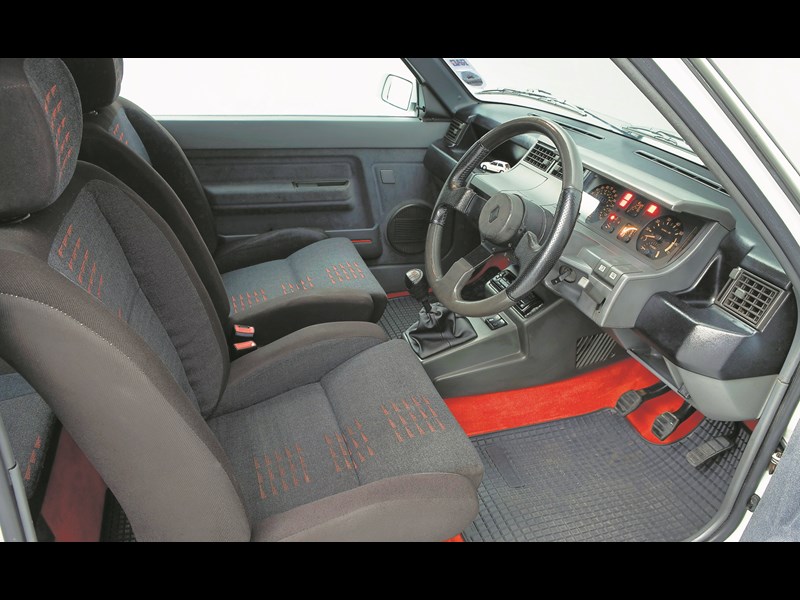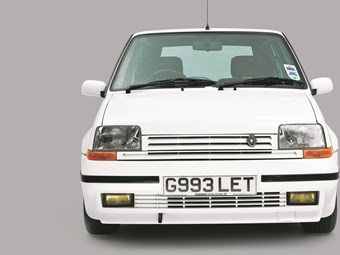Can’t afford an original R5 Turbo? Happily the Phase 2 GT Turbo offers similar thrills at a fraction of the price. We find out exactly how to bag yourself a good one

The GT Turbo isn’t just a fierce engine stuffed into a shopping car chassis – Renault really went to work on the suspension too. This is a superb handling car, especially the way the front end just dives into corners and then feels nailed to the road.
Sometimes, it’s almost as if it grips too much. At the point where you’re expecting to turn the wheel more to get around a bend, the car actually digs in harder, forcing you to wind-off lock.
Anyone who’s ever driven a Clio 172, or its descendants, will recognise the way the GT Turbo behaves. Add in a sweet, slick gear change and the GT Turbo is a mighty slice of old fashioned fun. It’s one of those rare cars that are incredibly easy to drive hard. The ride is more composed and gentle on Phase 2 cars, which makes the GT Turbo a usable car on the road as well as the track.
It has the desirable qualities of all great hot hatches – it’s exciting, addictive and spurs you into driving it harder.
VITAL STATISTICS
1987 Renault 5 GT TurbO
Engine 1397cc/4-cyl/OHV
Power (bhp@rpm) 118bhp@5750rpm
Torque (lb ft@rpm) 122lb ft@3750rpm
Top speed 120mph
0-60mph 7.3sec
Consumption 28mpg
WHAT TO LOOK FOR
BODYWORK & CHASSIS
The metalwork on these cars is really thin, so look for any covered damage. Wonky panel alignment is fairly common as a result. Regular R5 rust spots are numberous and include along the bottom of the front windscreen, rear window rubbers, rear wheel arches, wings, tailgate, doors and floorpan. Also examine the outer sills, behind the plastic sill extensions, the inner sills and the front jacking points. Other common rust spots are the front and rear bumper mounting points.
ENGINE
The 5 Turbo’s pushrod 1397cc engine is prone to noisy tappets, but this is not something to be unduly worried about. Of more serious concern is a noisy camshaft – evident as a slightly deeper sound than the tappets. This noise means the camshaft is worn and it won’t be long before you have to replace it, an expensive task that involves removing the head itself. An engine that has been serviced regularly and maintains a good oil pressure should easily manage 150,000 miles before rings, main bearings or valve guides need replacing.
On the test drive, be sure to find a series of left and right turns. While going round the corner, listen out for a knocking noise coming from the opposite side you are turning into. This noise indicates a driveshaft in need of replacement. When driving along at about 30mph in fourth gear, open the window and listen for a knocking noise coming from the engine. This is the big end bearings knocking and if you do hear this, then walk away from the car, as a full engine rebuild will be required imminently. Make sure that the car does not misfire when on boost – this could simply be down to incorrect ignition timing or a more serious engine fault. The key to reliability is in accurate fuel set-up, and using super unleaded fuel to prevent pre-detonation. Check what boost is being used and ask lots of questions about how the fuelling has been set up.
RUNNING GEAR
When switching on the ignition, make sure that the oil light, battery light and handbrake light come on, and that the oil pressure gauge shoots up. This acts as an oil level reading until the engine is switched on and then it turns into an oil pressure gauge. When you start the car, make sure that the oil pressure gauge moves up and down with the revs. If the pressure gauge is sitting flat on the bottom of the gauge then it either means there is no oil pressure and that the head gasket has gone, there’s something major internally wrong with the engine, or the gauge is simply not working.
Check that all the electrics inside work as French cars of the 1980s/1990s don’t have the best reputation in this area. The R5 uses a chemical sealant in the front windscreen – they are known for coming away from the rubber because of movement in the A-pillars, so when inside the car gently push the windscreen to see if it moves.
INTERIOR
Interiors are generally hard wearing, but the driver’s seat outer side bolster foam breaks down. New bolsters are still available from Renault, but cheaper replacements can be found easily enough secondhand. If the front seats rock excessively on their mountings, check the two pivot bolts that couple them at the front to their sub frames, as they come loose and can need tightening from time to time. The electric windows are known for being slow, caused by the motor’s old dried-out grease and perished rubber guides. Some time spent cleaning and re-greasing the mechanism can vastly improve things. However, sometimes the cause of the slow windows and central locks is simply corroded electrical connectors. These fail to pass adequate current to operate the motors and replacement for new is required as cleaning has little or no effect.
OUR VERDICT
The Renault 5 GT Turbo is a rare beast on UK roads, so finding one will be difficult and finding a good one even harder. Certain parts are now scarce, meaning they can be very expensive. The simplest advice is to buy the best example your budget will allow, as the cost of refurbishing a duff car is likely to be significantly higher than the price you’ll pay for a decent one in the first place. These cars are still prime targets for thieves, so you’ll definitelty want to look into an upgraded anti-theft system, if this hasn’t been done already. The GT Turbo is a highly usable car, definitely capable of daily driver duties as well as weekend blasts.


